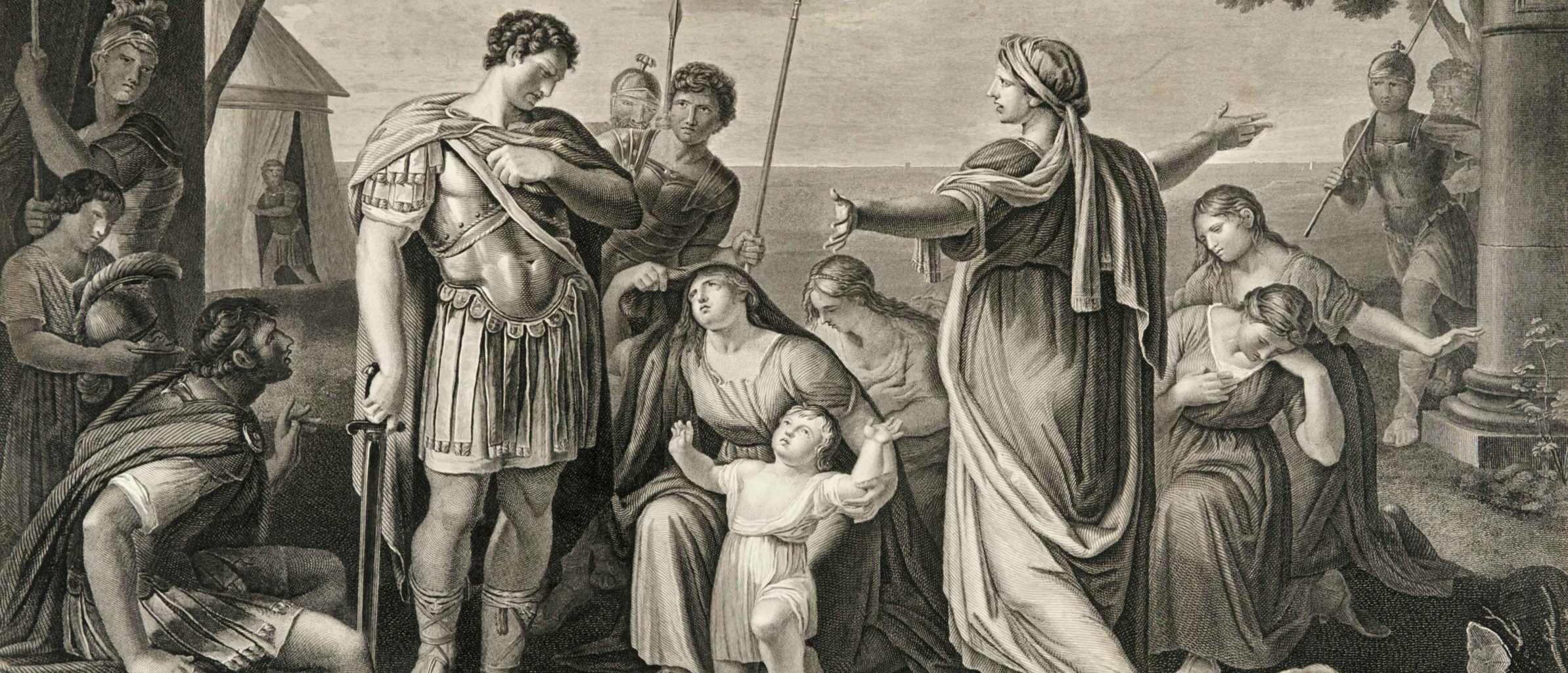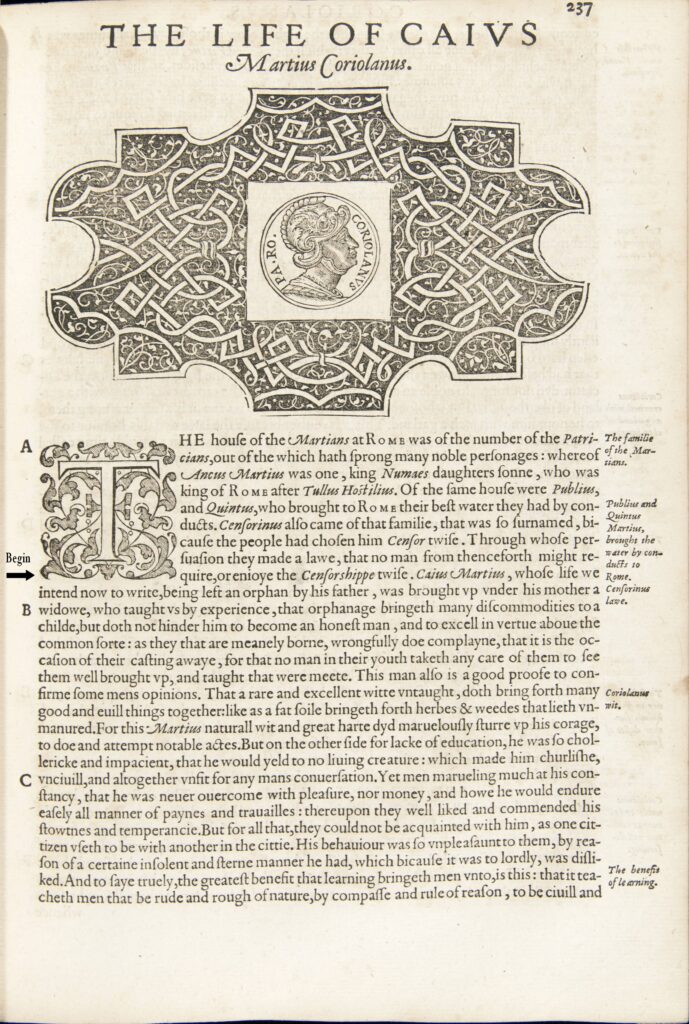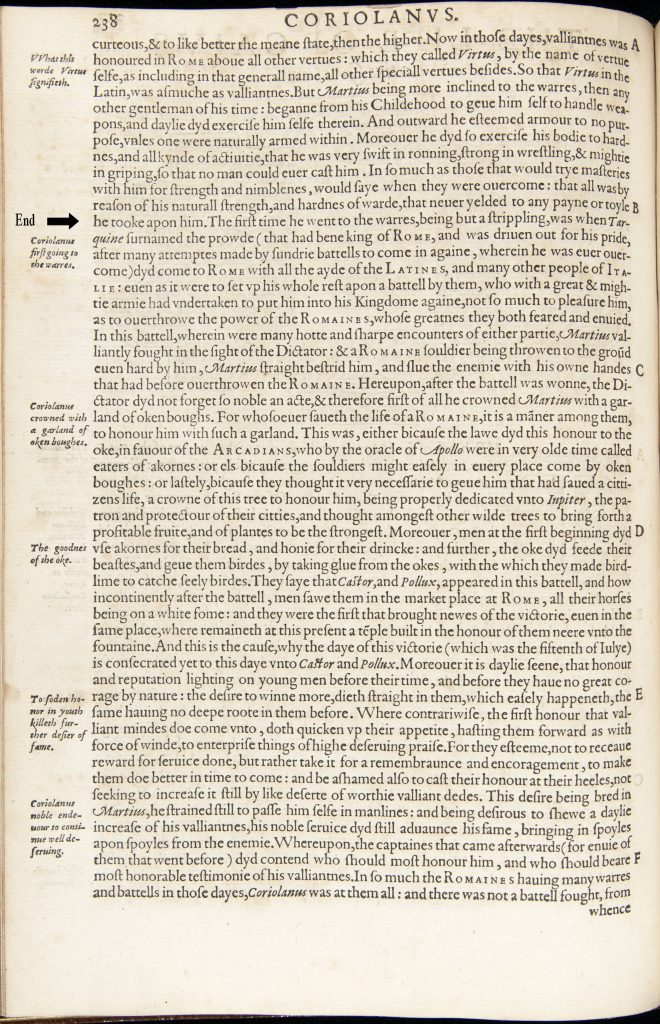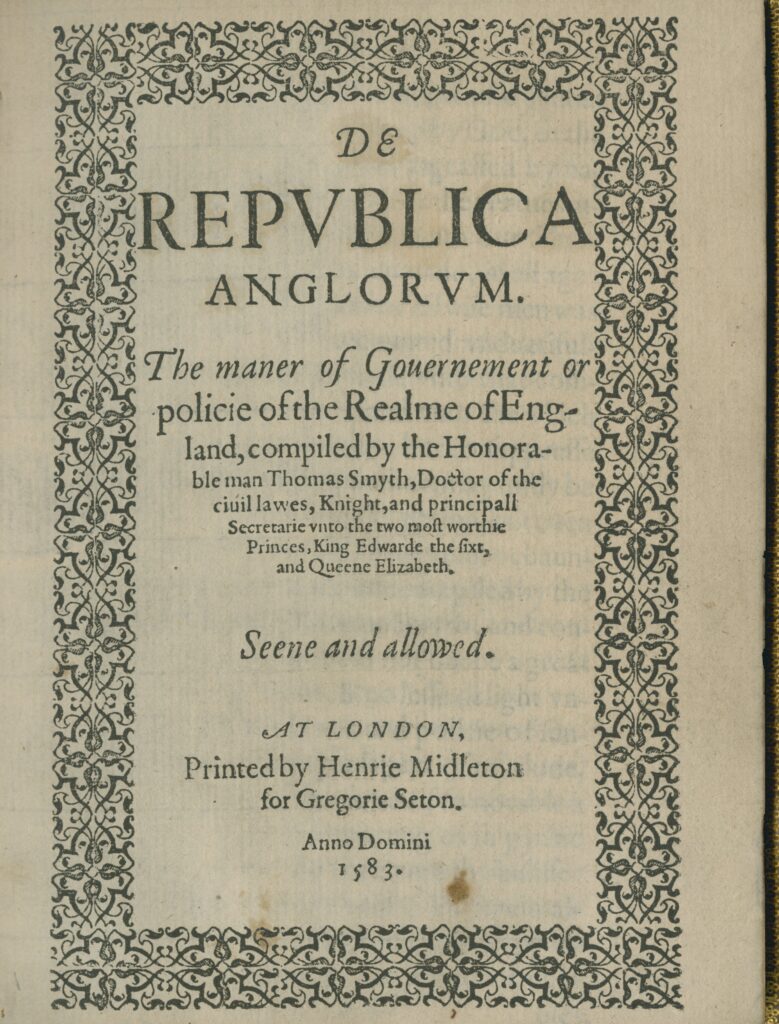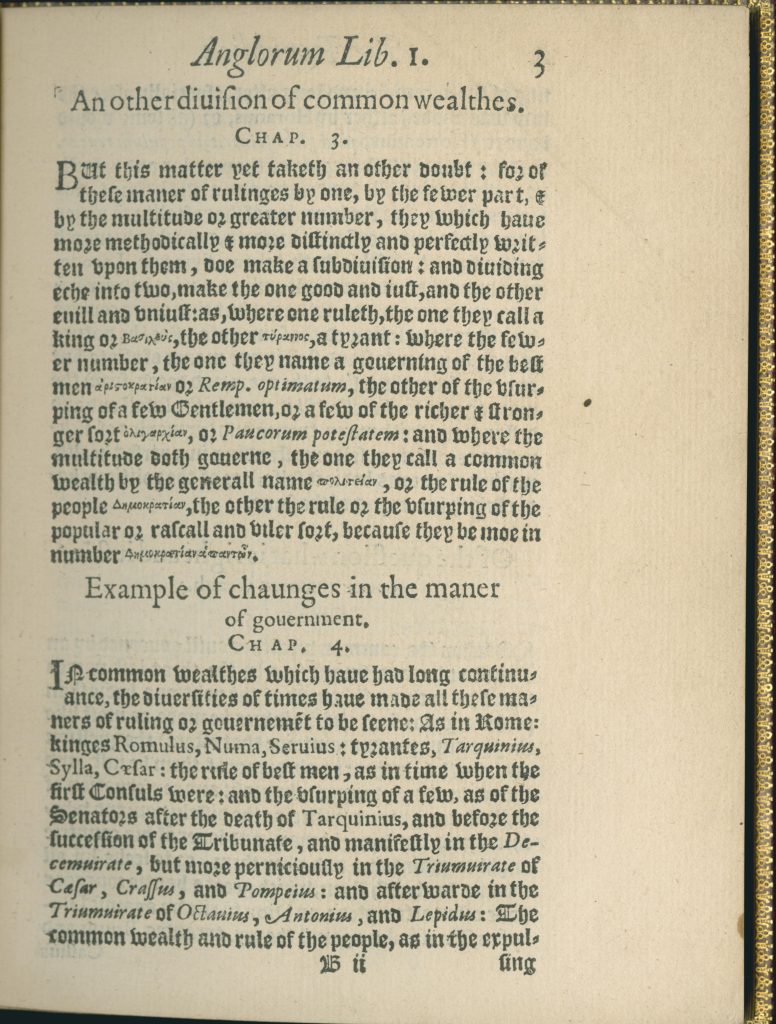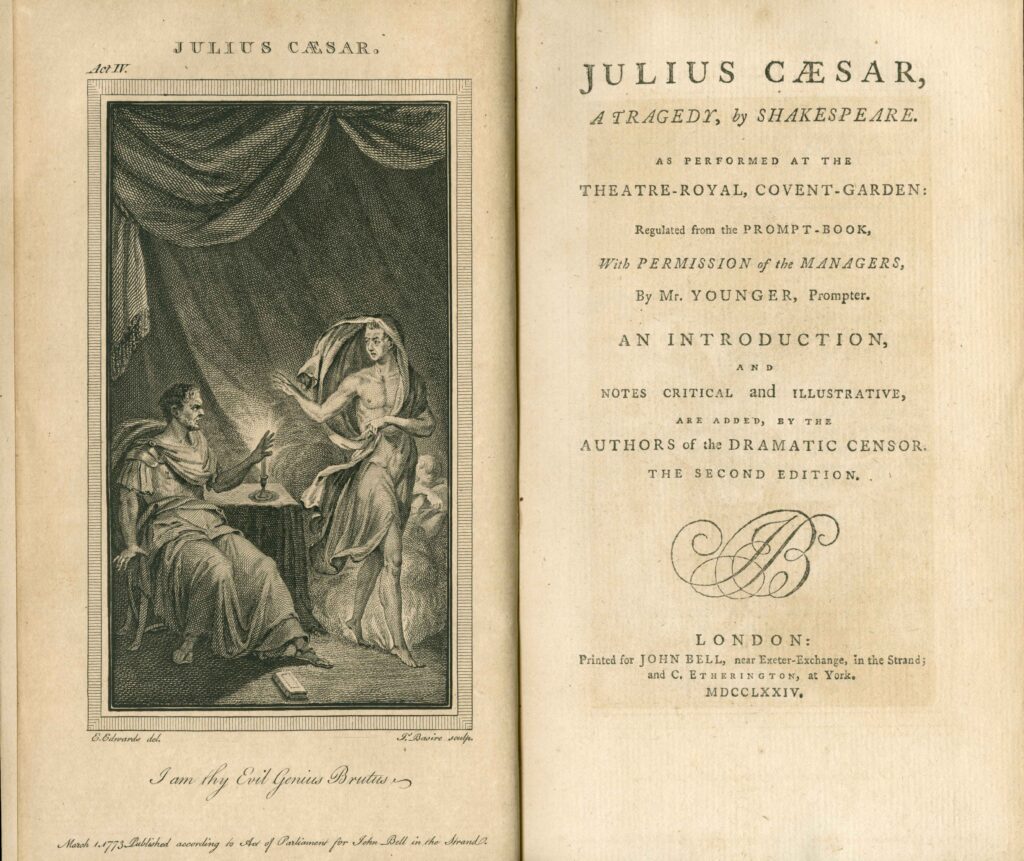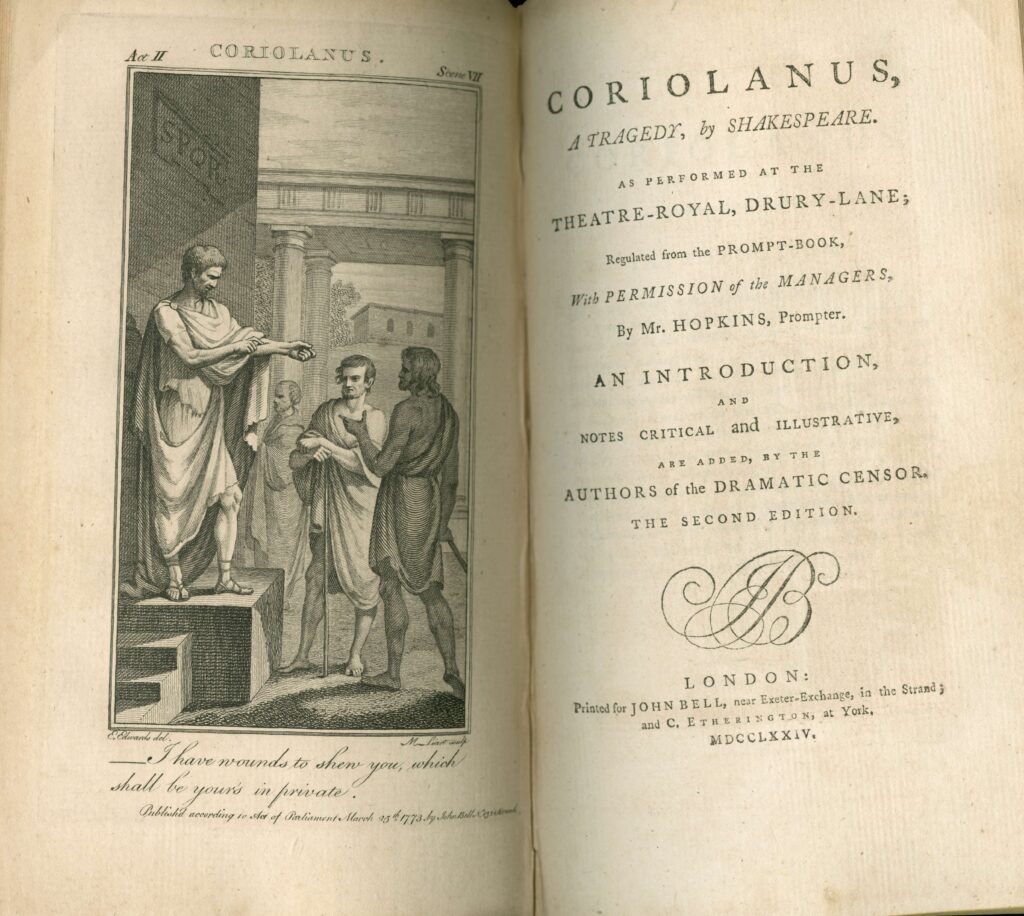Introduction
In September of 2023, a viral TikTok trend spurred people to ask friends, family, and partners how often they think about the Roman empire. The surprising answer from many men of a certain demographic was: at least once a day. A similar viral sensation in Shakespeare’s England would have yielded similar results. The Roman Empire, for so many then as now, stood as the exemplar of ultimate political, military, and colonial might and success. Since the fall of Rome, nation after nation seeking to take its place as the new world superpower has sought to emulate Rome’s example and cast itself as its successor: as with the modern United States, so with early modern England. Shakespeare and his contemporary playwrights thus turned to Rome as a setting, first of all, because it would sell tickets to eager audience members; but second because it offered a way to question and clarify the aspirations of the English nation.
For many people in Renaissance England, the ancient Roman republic did not seem remote or exotic. Instead, it served as an important precedent in politics and history, one which had bearing on events and people in Britain.
When William Shakespeare first staged his Roman tragedies Julius Caesar (1599) and Coriolanus (c. 1608), he did not introduce his audience to new stories. Rather, he reworked characters and events with which most of his audience would have been familiar. For many people in Renaissance England, the ancient Roman republic did not seem remote or exotic. Instead, it served as an important precedent in politics and history, one which had bearing on events and people in Britain.
The similarities between seventeenth-century England and classical Rome may not be obvious to twenty-first-century readers. The English were governed by a monarch, or individual ruler, and had been for as long as people could remember. The Roman republic was founded in 509 BCE with the overthrow of the Etruscan king Tarquin the Proud, and the rebels’ oath to make the people free of tyranny. The republican government, which lasted for almost five hundred years, included three principal institutions: the Senate (three hundred members of the aristocracy who held life-long posts); the tribunes of the people (two powerful officials who represented the lower-class citizens, or plebeians); and the consuls (two men elected by the Senate and approved by the plebeians). While aristocrats were often wealthy landowners from dynastic families, Roman plebians came from a wide spectrum of the working classes: from rich merchants to impoverished cobblers. During the republic’s final decades, there was also a dictator, the position that Julius Caesar held at the time of his assassination.
Yet these differences in political structure are not quite as firm as they appear. As the scholar Oliver Arnold explains, “England was a ‘mixed-estate’ rather than an absolute monarchy.” The monarch had to obtain the consent of Parliament, including the House of Lords and the House of Commons, in order “to levy certain kinds of taxes and enact certain kinds of law.” Early modern writers frequently compared the English Parliament to the Roman republic’s Senate and popular tribunate. The English were also mindful of Rome’s role in their early history: Julius Caesar successfully invaded Britain in 54 BCE, and the Roman Empire, which succeeded the republic, controlled Britain from 77 to 407 CE. At the broader level of political culture, English people strongly identified themselves as “free” in ways that (they believed) citizens of the Roman republic had been and others in Europe were not. They accepted that they were subject to a monarch, but they drew a distinction between the just ruler and the tyrant.
Shakespeare’s representations of rebellion in classical Rome also resonated with political turmoil in the England in which he lived. Henry VIII had established the Church of England and made himself head in 1534. In the century that followed, Catholic conspirators repeatedly tried—or were accused of trying—to regain control of the crown, while Protestant rulers worked to consolidate the national Church of England. Elizabeth I, who ruled Britain from 1558 to 1603, thwarted numerous attempts to depose her and install Mary, Queen of Scots, as the ruler of England. Even in her final years, Elizabeth faced a small (nonreligious) insurrection led by her former favorite, the Earl of Essex. Because Elizabeth had no heirs, the question of who would succeed her was the source of considerable anxiety and political jockeying at the turn of the century. When James I assumed the throne in 1603, he alleged three major plots to overthrow him in just the first three years of his reign.
Shakespeare’s Romans may not speak to Christian religious conflicts, but they certainly raise questions about the consequences of political overthrow, the motives of conspirators, the effects of charismatic individual leadership, the obligations of virtuous citizenship, and the roles of the people and the aristocracy in government. In short, Julius Caesar and Coriolanus explore issues that would have resonated strongly with Shakespeare’s contemporaries. The documents that follow develop the context for Shakespeare’s Roman plays. They include excerpts from his available sources on classical Rome, representations of Rome by other Renaissance writers, and, finally, interpretations of Shakespeare’s characters by artists from later centuries.
Please consider the following questions as you review the documents:
- How did Shakespeare’s contemporaries represent classical Rome? What relationships do they suggest between ancient Rome and Renaissance England? Which issues does Rome seem to raise for Renaissance writers or allow them to explore?
- In what ways do Shakespeare’s plays reinforce or differ from other Renaissance representations of Rome? Which issues does he call attention to, revise, or adapt in his retelling of Roman history?
- How did artists portray Shakespeare’s characters in the centuries that followed the original staging of Julius Caesar and Coriolanus? Based on the sources in the essay, what about these plays mattered most to subsequent audiences?
Shakespeare’s Sources
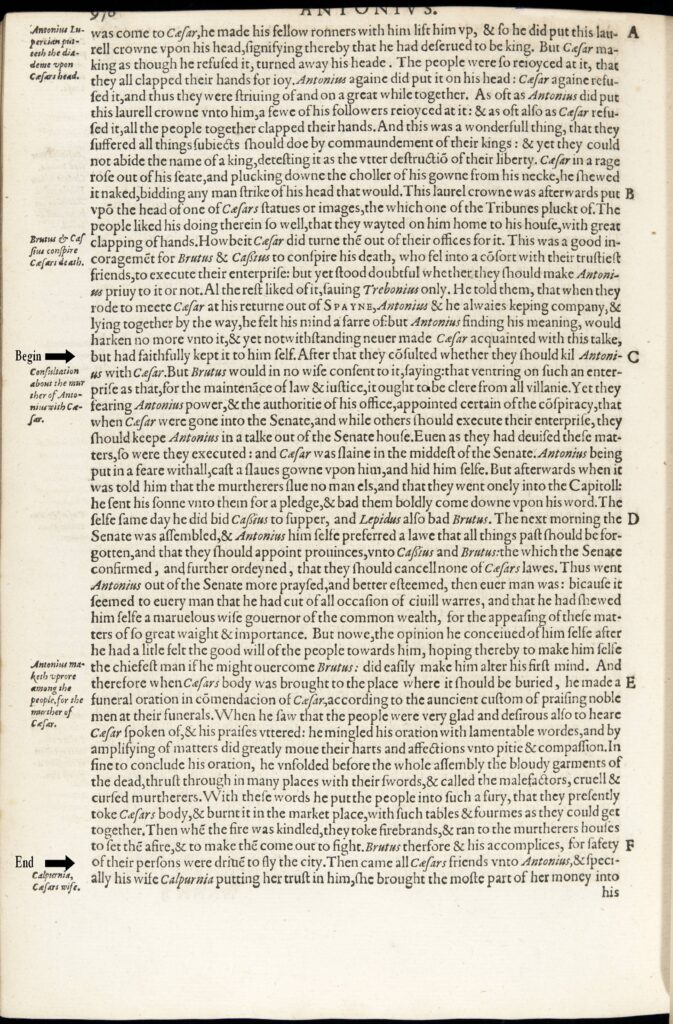
Plutarch was a Greek writer who lived from approximately 46–120 CE. His most influential work traces the biographies and moral characters of famous Greeks and Romans. Latin editions of this work, known as Parallel Lives or Plutarch’s Lives, were published in Europe during the 1400s. The French writer Jacques Amyot translated it into French in the 1560s, and Thomas North translated this version into English in 1579, when it was published in London. North’s translation was enormously influential at the time and is considered a significant work of sixteenth-century English literature in of itself. It contains enough literary embellishment and accidental errors that scholars usually emphasize that one is reading North’s Plutarch or will simply cite a passage as from North (leaving out Plutarch’s name). North’s Plutarch was Shakespeare’s main source for his Roman plays, Julius Caesar, Antony and Cleopatra, and Coriolanus. These passages were taken from North’s translation of Plutarch and his account of the lives of Coriolanus and Mark Antony (Antonius), who led the people against Julius Caesar’s assassins.
Selection: Plutarch, translated by Thomas North, The Life of Caius Martius Coriolanus, 237-238 (1579).
Questions to Consider:
- How does Plutarch/North introduce Coriolanus? What information about Coriolanus’ family and childhood seemed worth including?
- Describe Coriolanus’ moral character based on this account. What are his virtues and his weaknesses?
- Compare Plutarch/North’s portrait of Coriolanus to Shakespeare’s. What differences and similarities do you notice between the two accounts? Is Coriolanus an admirable figure in Plutarch’s Lives or Shakespeare’s play? Is he sympathetic? Cite examples from the texts to support your claims.
- Consider Plutarch/North’s description of Antonius’ actions following Caesar’s murder. What do these actions reveal about Antonius’ character?
- Compare Plutarch/North’s representation of Antonius to Shakespeare’s Antony in Julius Caesar, particularly in Act III. What differences and similarities do you notice? How does Shakespeare build on and develop Plutarch/North’s account?
The Geography of Ancient Rome
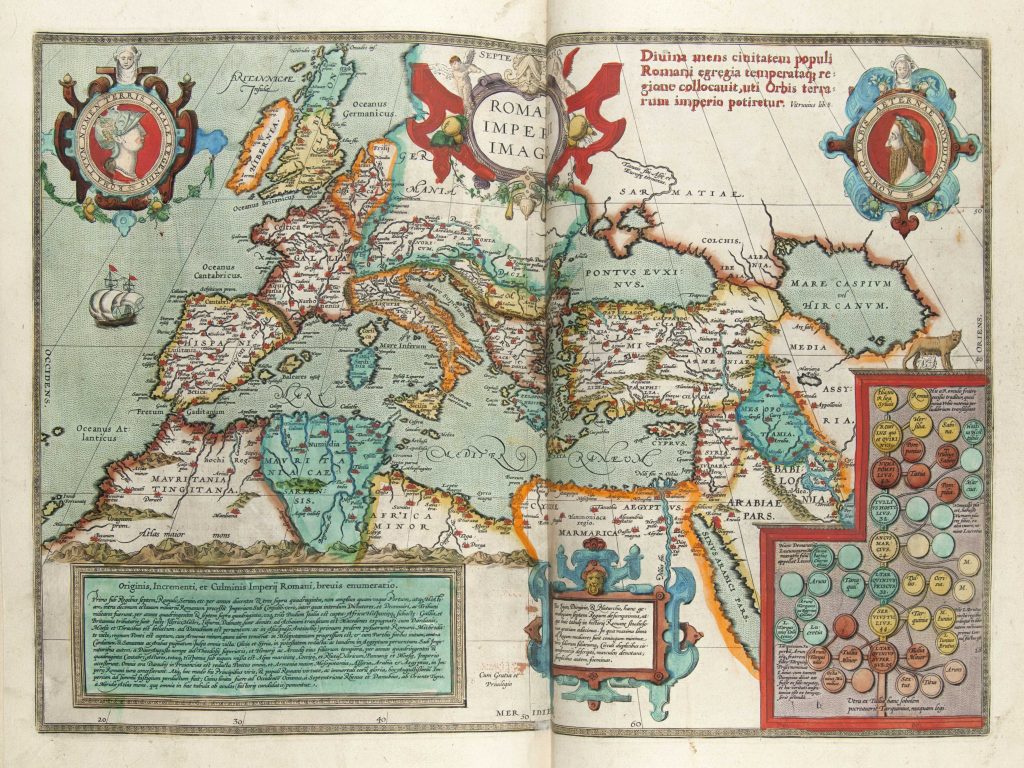
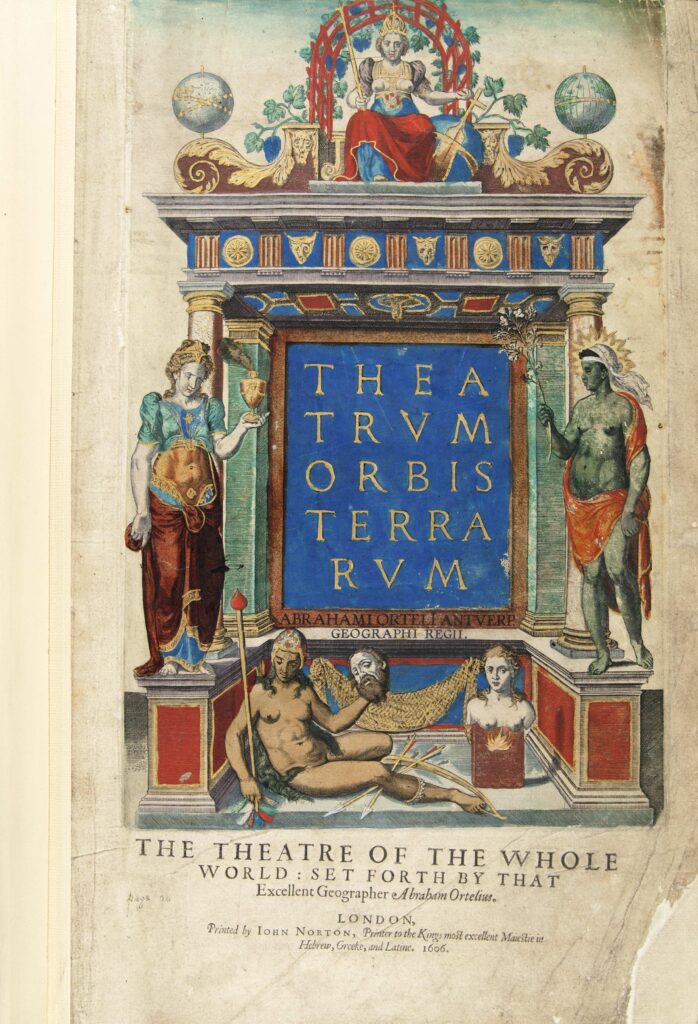
The map reproduced here, by Abraham Ortelius, representing the ancient Roman Empire, was printed in England in the seventeenth century. Ortelius was a sixteenth-century Flemish scholar and geographer who lived in Antwerp, a city in present-day Belgium. He embarked on a project to gather together the collected knowledge of sixteenth-century cartography and, in 1570, published the first modern world atlas Theatrum orbis terrarium, or “The Theater of the Whole World.” This first edition included seventy maps, each accompanied by a page of explanatory text, as well as the names of the thirty-three cartographers and eighty-seven geographers whose work Ortelius had consulted. The atlas was an immediate success, praised by scholars and kings throughout Europe. It was translated from its original Latin into the major vernacular, or spoken, languages of Europe. Thirty-four editions were published from 1570 to 1612, often with the addition of new maps and references. The English edition was printed in London in 1606.
While many of the Theatrum maps portrayed the contemporary world, some were historical, like this map of the Roman Empire. A full translation of the Latin text of the lower left cartouche appears below. The upper left cartouche portrays the Roman poet, Tibullus, with the quote, “Rome, your race is destined to rule the world.” The upper right cartouche portrays Romulus, the founder of Rome. The genealogical tree on the lower right shows the seven Roman kings who ruled until the founding of the republic. The kings’ names appear in the central line of double circles with Romulus at the top and Tarquin the Proud (Tarquinius Superbus) at the bottom. Their wives and children are represented by the lesser lines and circles along the sides.
Questions to Consider:
- Examine the frontispiece of Ortelius’ Theatre of the Whole World. How does this page, with its symbolic figures, serve to introduce the work? What does it suggest about Ortelius’ ambitions for the book?
- Describe Ortelius’ map of the Roman Empire. What information does it provide about ancient Rome? Why do you think Ortelius included such brilliant colors and elaborate decorations? What do these features suggest about the meaning of maps in Renaissance Europe?
- How do the text boxes, the portraits, the family tree, and the other illustrations relate to the geographic representation of continents and seas?
- Which political or national entities does the map identify? What kinds of information does the map leave out?
- The lower left cartouche (translated above) offers “a short list of the origins, growth, and culmination of the Roman Empire” from the first king through the last emperors. How does the map visually convey this history? Why do you think the Roman republic, which existed between the time of the kings and the emperors, receives so little attention?
- What does Ortelius’ map suggest about sixteenth-century European perceptions of ancient Rome?
Classical Rome and Renaissance England
Important early modern English political thinkers, historians, and literary figures often had Rome on their minds. Sir Thomas Smith was a political and legal theorist as well as a member of Parliament in the mid-sixteenth century. His De Republica Anglorum, or “Of the English Republic,” was published in 1583, posthumously (i.e., after his death). The scholar Oliver Arnold notes that the “treatise quickly became one of the most important and frequently invoked accounts of English political and legal institutions.” Throughout the work, Smith refers to classical Rome—as opposed to other European countries—in order to describe English institutions. In the first chapter, Smith identifies three kinds of commonwealth: monarchy (rule by an individual); aristocracy (rule by a small number); and democracy (rule by the “multitude”). In the passages reproduced below, Smith distinguishes between just and unjust rulers in all three forms of government and considers whether it may ever be right for citizens to overthrow their rulers.
Selection: Thomas Smith, De Republica Anglorum: The Maner of Government or Policie of the Realme of England, 3-5 (1583).
Samuel Daniel was a respected poet and playwright whose works influenced Shakespeare. His long poem, The Civile Wars, offers a history of the War of the Roses, the conflict between the English dynasties of Lancaster and York between 1455 and 1485. In the passages reproduced below, Daniel compares the Battle of Towton, which the Yorkist army won, to Julius Caesar’s defeat of Pompey at Pharsalus in 48 BC. (Pompey was allied with Cato and the Senate.) In this passage, the poet is addressing his muse. Together, these works by Smith and Daniel suggest how profoundly Renaissance understandings of Roman history informed English writers’ sense of their own nation’s history and identity.
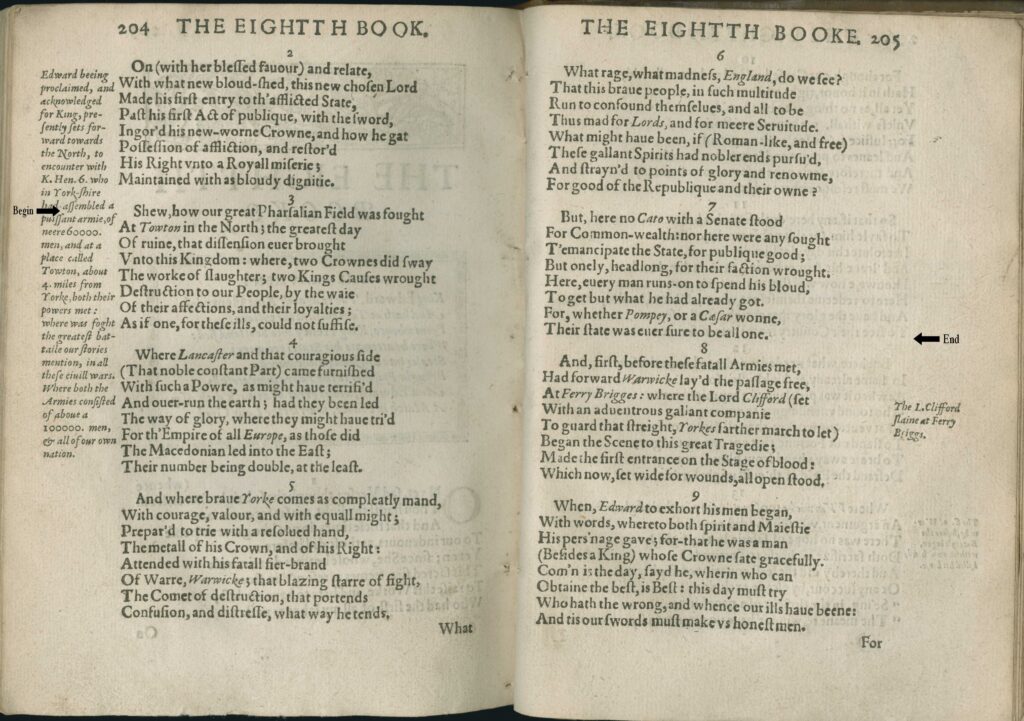
It may be surprising to learn that Shakespeare and his fellow playwrights struggled with the idea of democracy that Thomas Smith outlined and that the Roman Republic developed in its own way. When Shakespeare represents the “multitude” on stage (Smith’s word for the group who rules in democracy and a word Shakespeare uses often), whether as a crowd of English subjects or Roman plebians, he often represents them as fickle, unintelligent, and easily manipulated. He appears to have been quite worried about the power of the masses, whereas he so often depicts marginalized individuals in his plays with striking sympathy. In Coriolanus, Shakespeare confronts the question of democracy most directly, and his crowd of citizens shows itself more capable of rational debate and self-determination than we see in similar scenes from Julius Caesar. It is worth asking yourself, however, whether either of these plays are optimistic about the wisdom of the multitude.
Questions to Consider:
- According to Smith, what is the difference between just and unjust government? Are citizens obligated to obey their rulers? In what situations, if any, are citizens right to overthrow their ruler? Does Smith seem to endorse such an act?
- How does Smith use examples from classical Rome to illustrate his points? What interpretations does he offer of figures such as Brutus, Cassius, and Julius Caesar?
- Why does Daniel refer to “rage” and “madness” in the Battle of Towton? What are the English fighting for?
- How does Daniel portray the Romans? What motivates their conflict?
- Does Daniel identify greater honor or nobility in either the English or the Roman causes? Why?
- Taking these two texts together, what conclusions can you draw about the meaning of classical Rome to Renaissance English writers? What is the role of Rome in these writers’ representations of English history and identity?
- What differences do you see in how the plebians, or citizens, are depicted in Julius Caesar and Coriolanus? The aristocrats?
Imagining Shakespeare’s Romans
The illustrations below of scenes from Shakespeare’s Julius Caesar and Coriolanus were published in the late eighteenth and early nineteenth centuries, long after Shakespeare’s death. They offer insight into the significance of these plays for later audiences. The first two engravings and title pages appear in Bell’s Edition of Shakespeare’s Plays, an elaborate nine-volume set of Shakespeare’s plays that was published in London. In the introduction to Julius Caesar, the editor John Bell praises the play for addressing “the spirit of Liberty” and “the love of our country,” and expresses the wish that modern “Senators” (i.e., members of Parliament) would read it annually. Bell writes less favorably of Coriolanus, suggesting that the protagonist’s heroism is “of a rather savage kind” that “does not touch the heart.”
Selection: Bell’s Edition of Shakespeare’s Plays, Julius Cesear, frontispiece and title page and Coriolanus, frontispiece and title page (1774).
This representation of Act V, scene iii, in Coriolanus is part of a later collection of large illustrations of scenes from Shakespeare’s plays. The London printer and engraver, John Boydell, commissioned artists to create paintings of the scenes, which he then reproduced as engravings and published together with the plays in 1803.
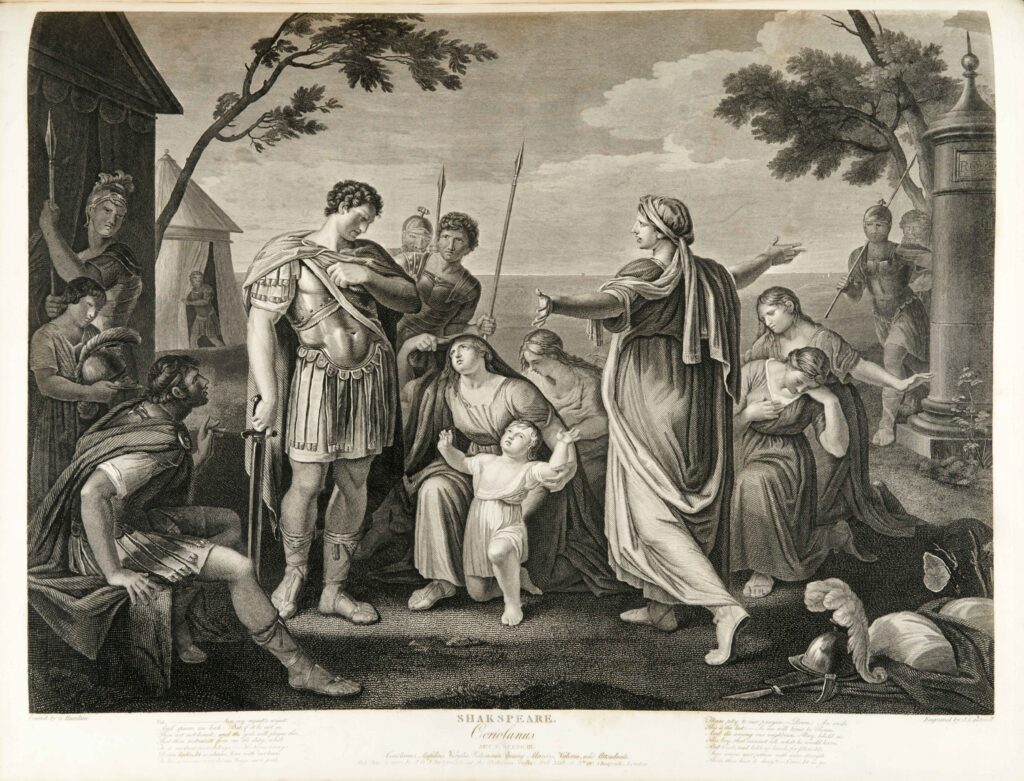
Questions to Consider:
- Describe the illustration of Caesar’s ghost appearing to Brutus in Act IV, scene iii, of Julius Caesar. Why do you think the editor John Bell chose this scene to represent the play? What is the significance of the scene to the play as a whole?
- Examine Bell’s frontispiece to Coriolanus. It shows Act II, scene iii, in which Coriolanus is asked to show his wounds to the citizens of Rome. Is this engraving an accurate representation of Shakespeare’s text?
- Examine each of the figures in the engraving of Act V, Scene iii, in which Volumnia pleads with Coriolanus to spare the city of Rome. Describe the postures, gestures, and facial expressions of the figures in this engraving. How does the artist interpret this scene?
- Taken together, what do these illustrations suggest about eighteenth- and early-nineteenth-century interpretations of both Shakespeare’s plays and classical Rome?
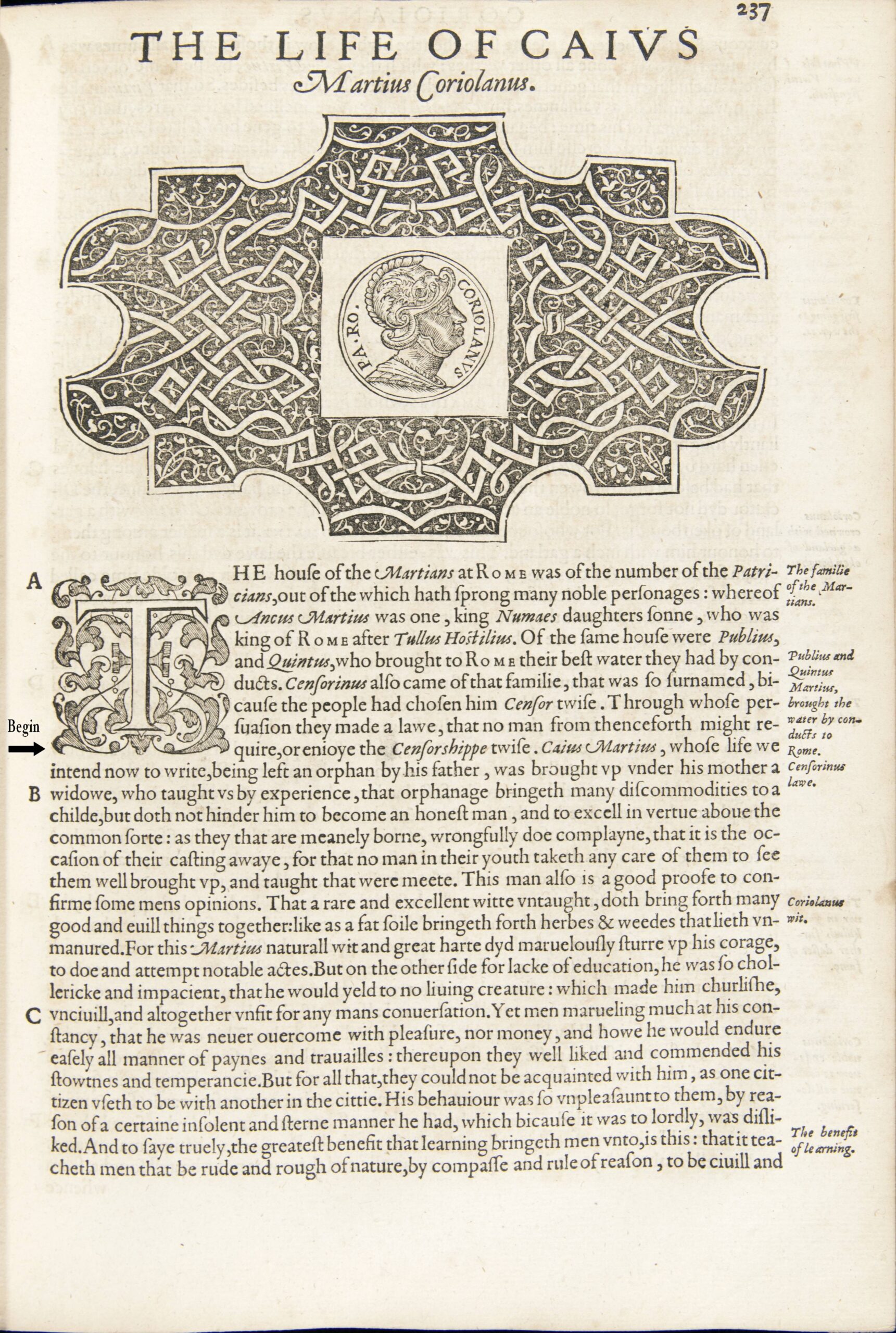
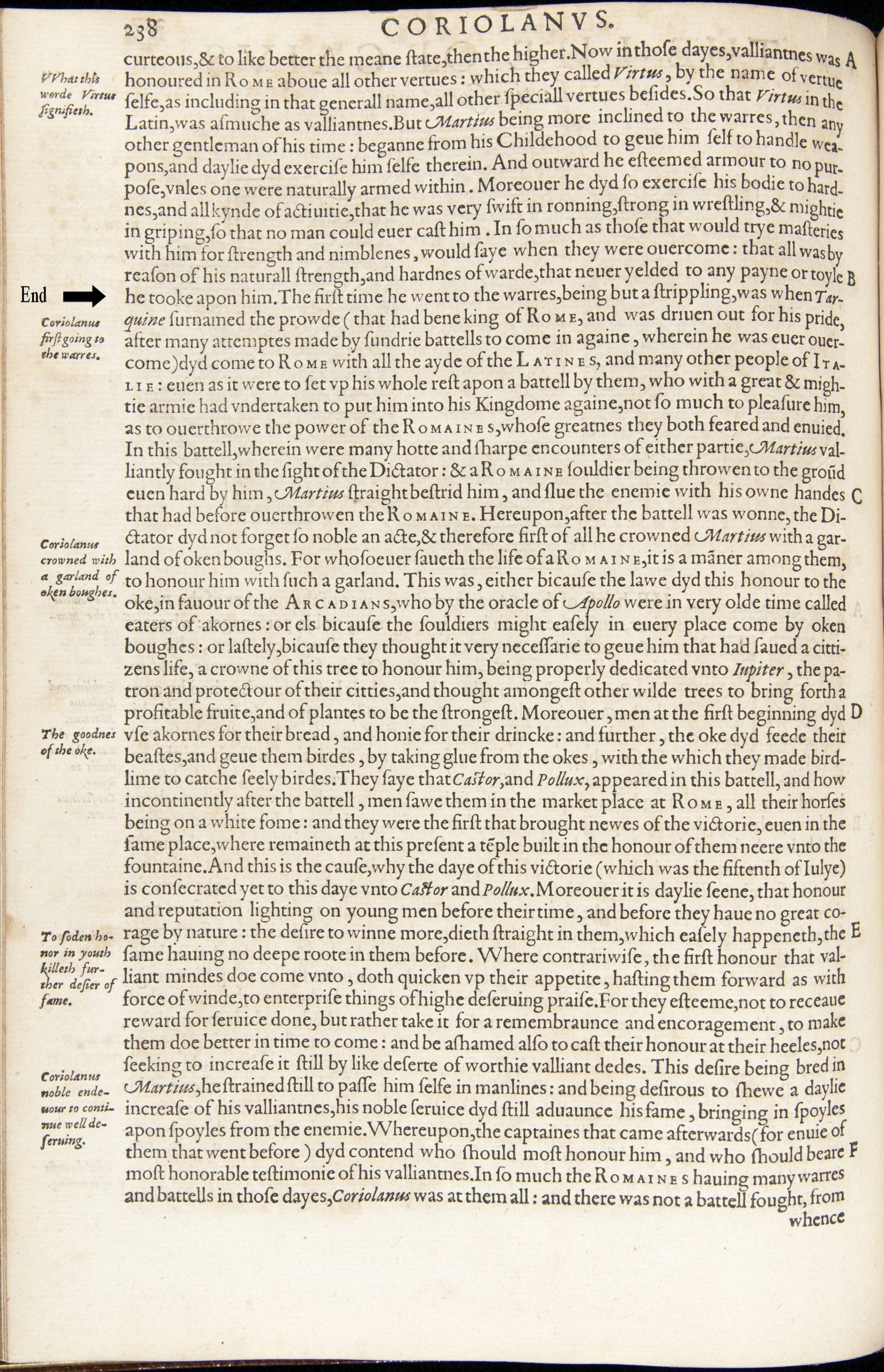
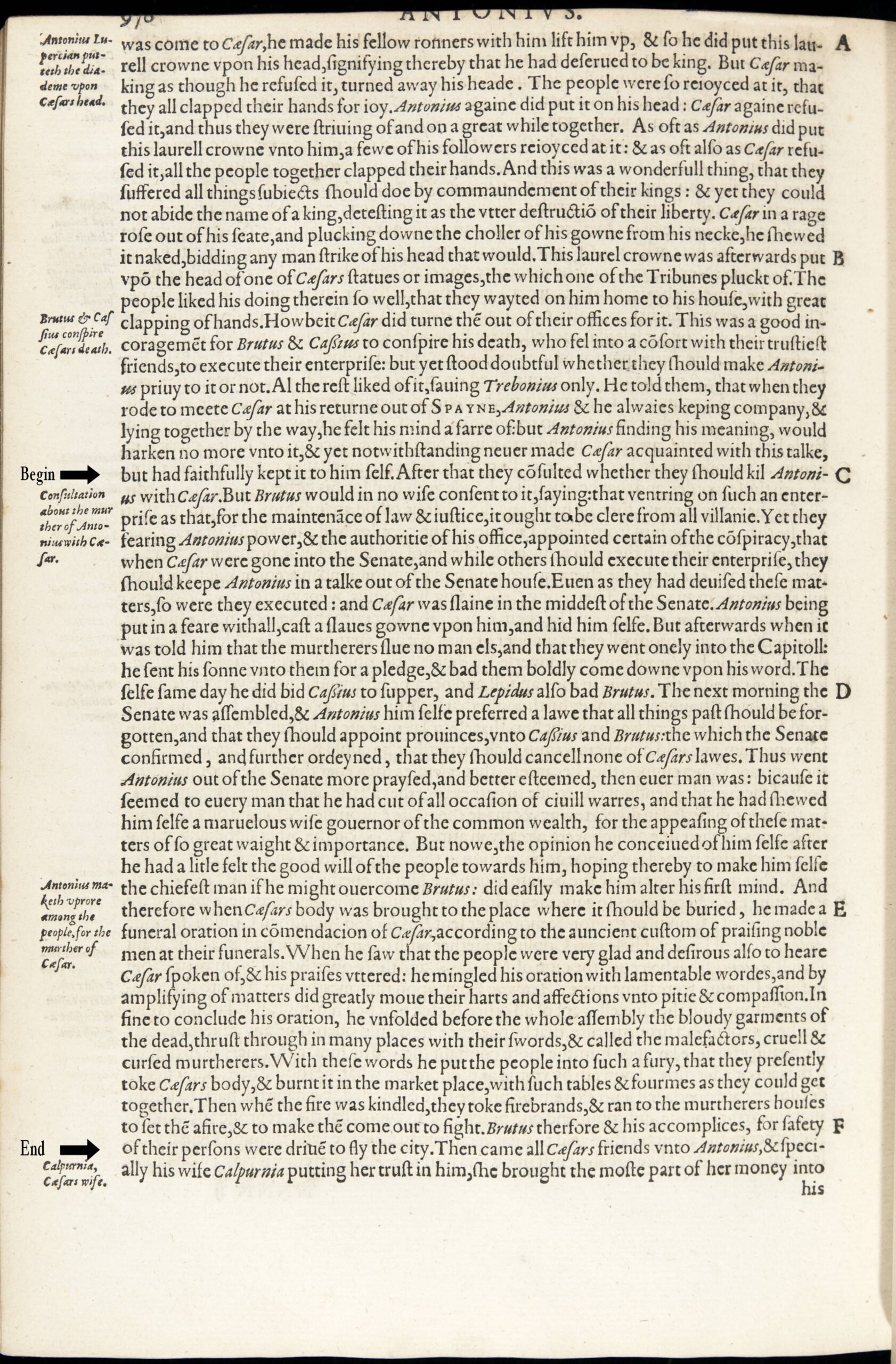
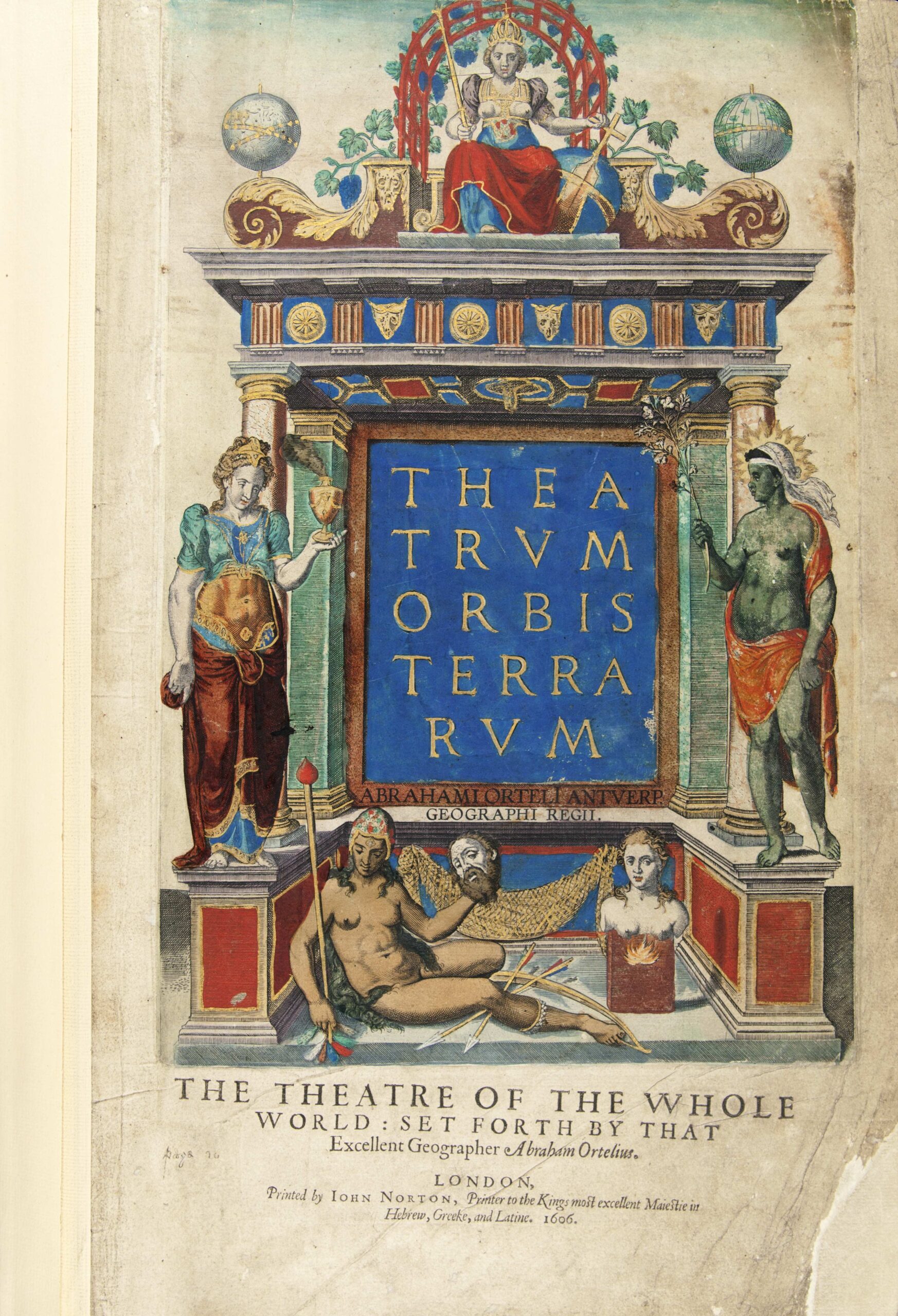
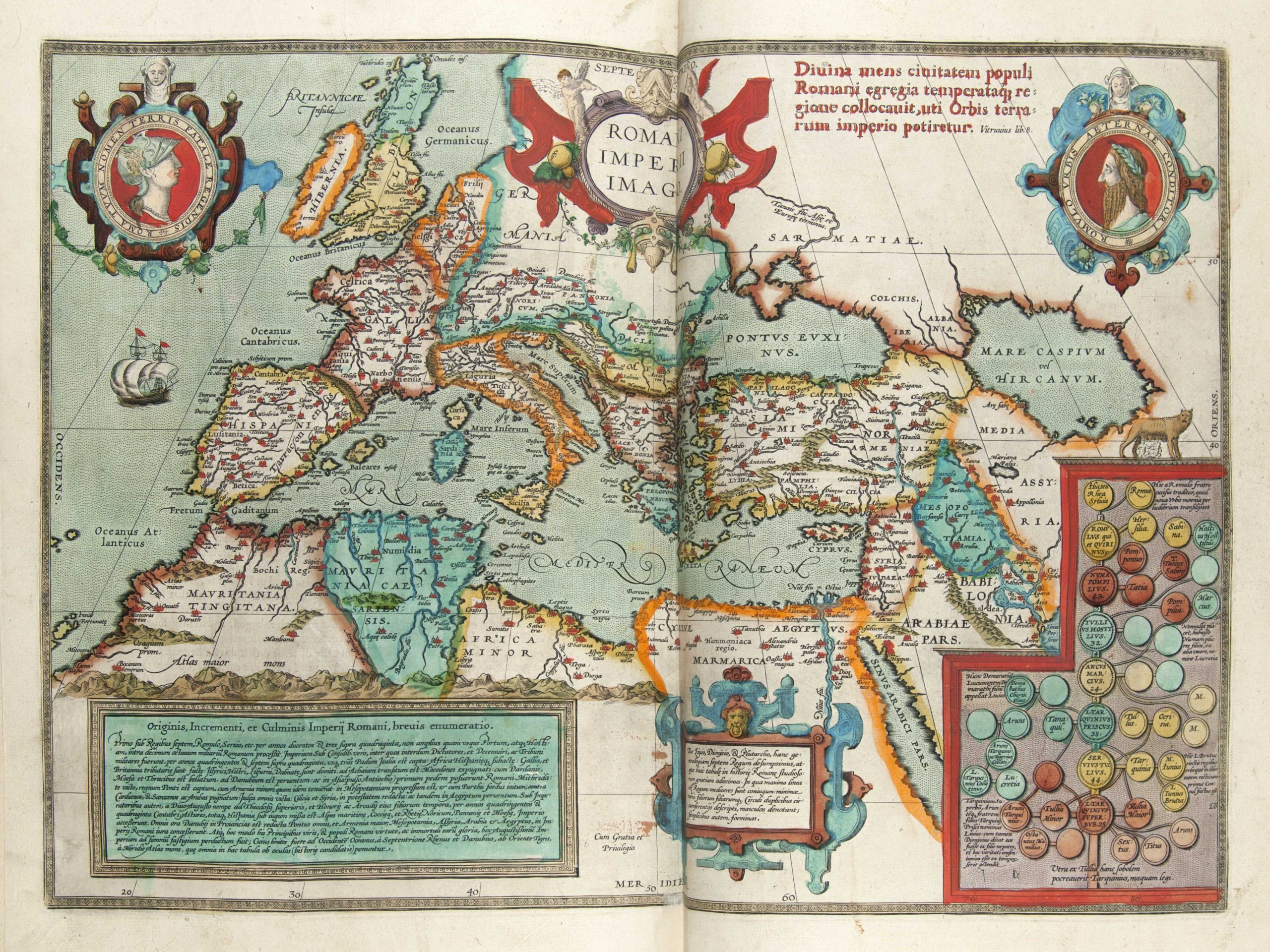
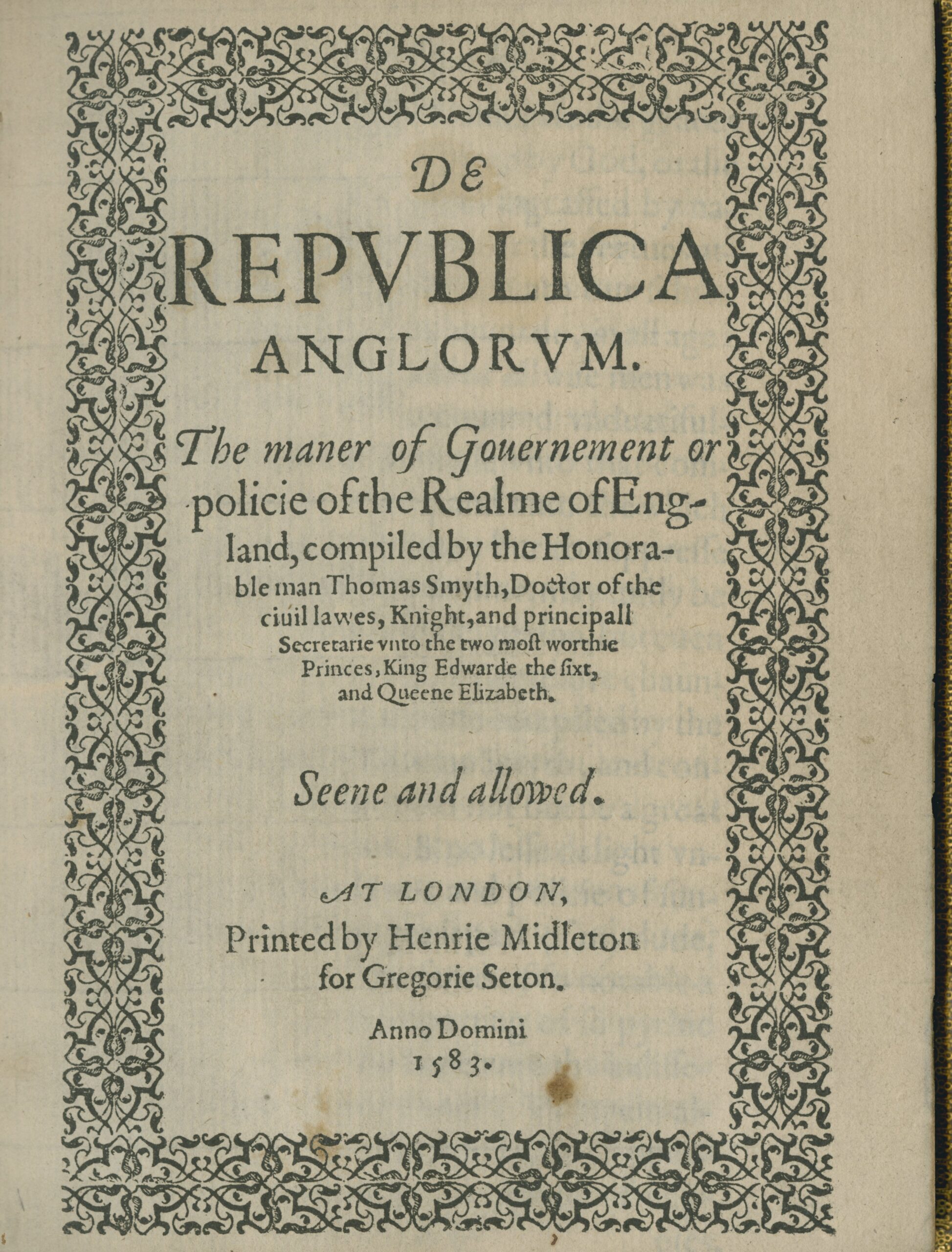
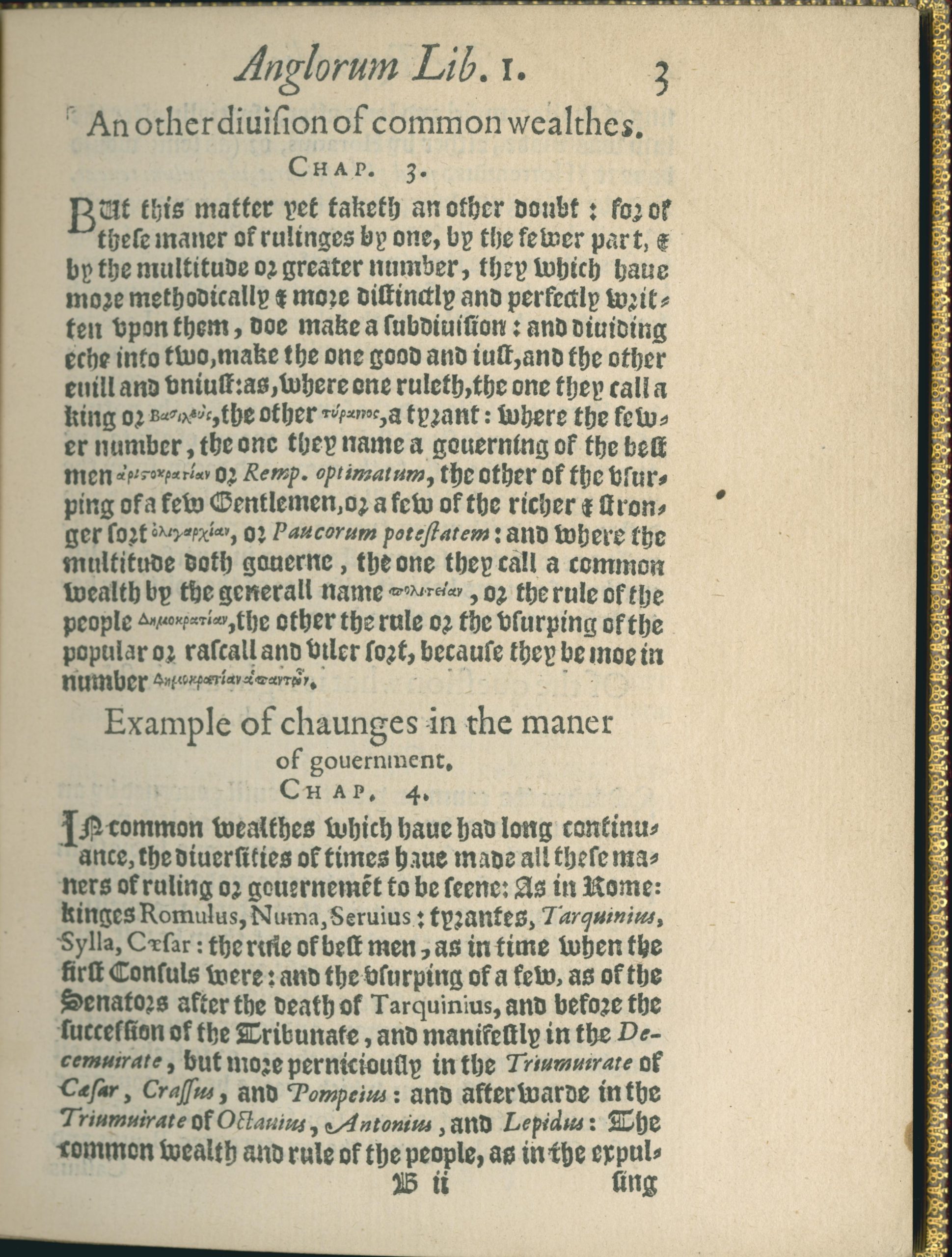
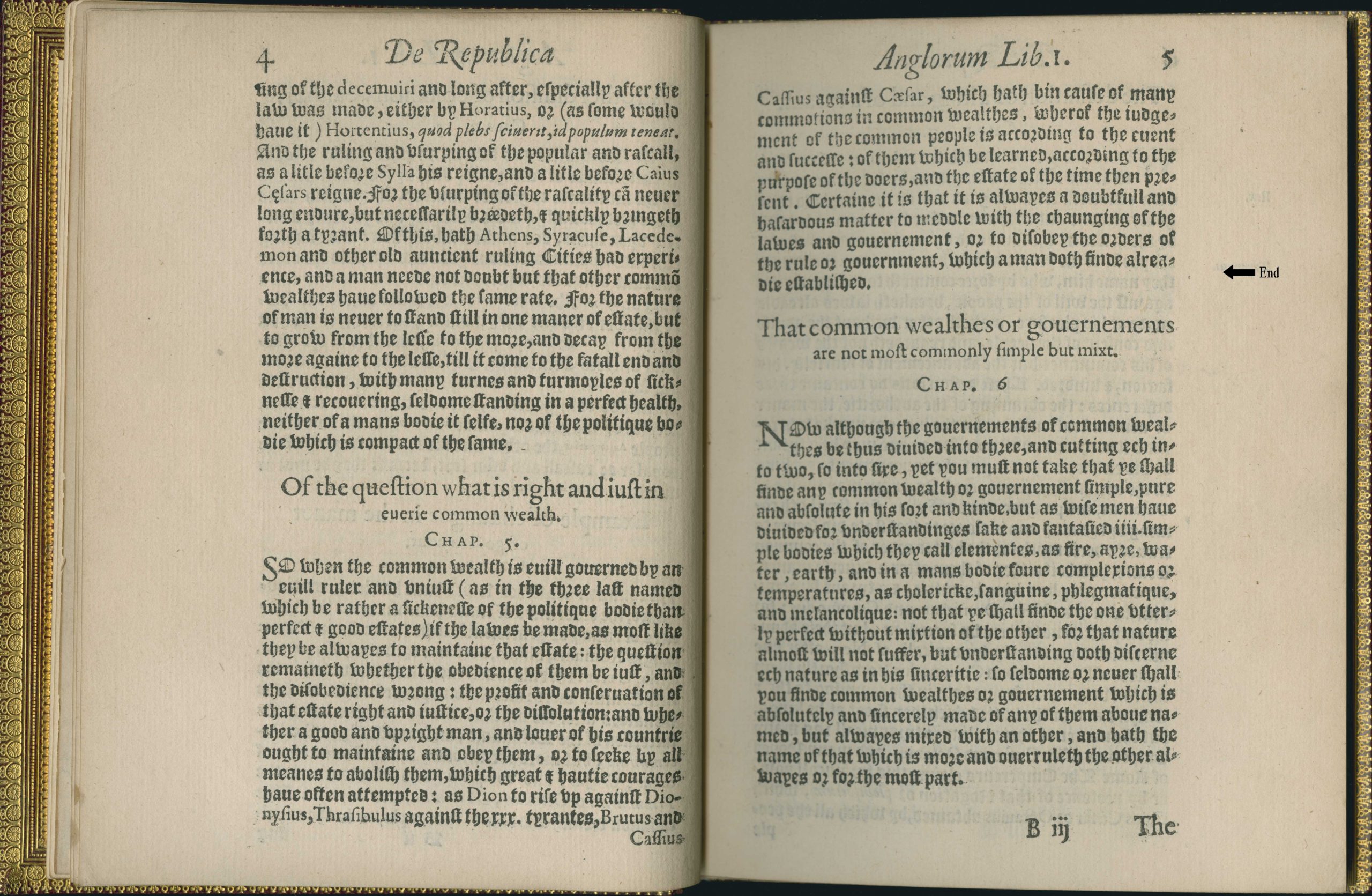
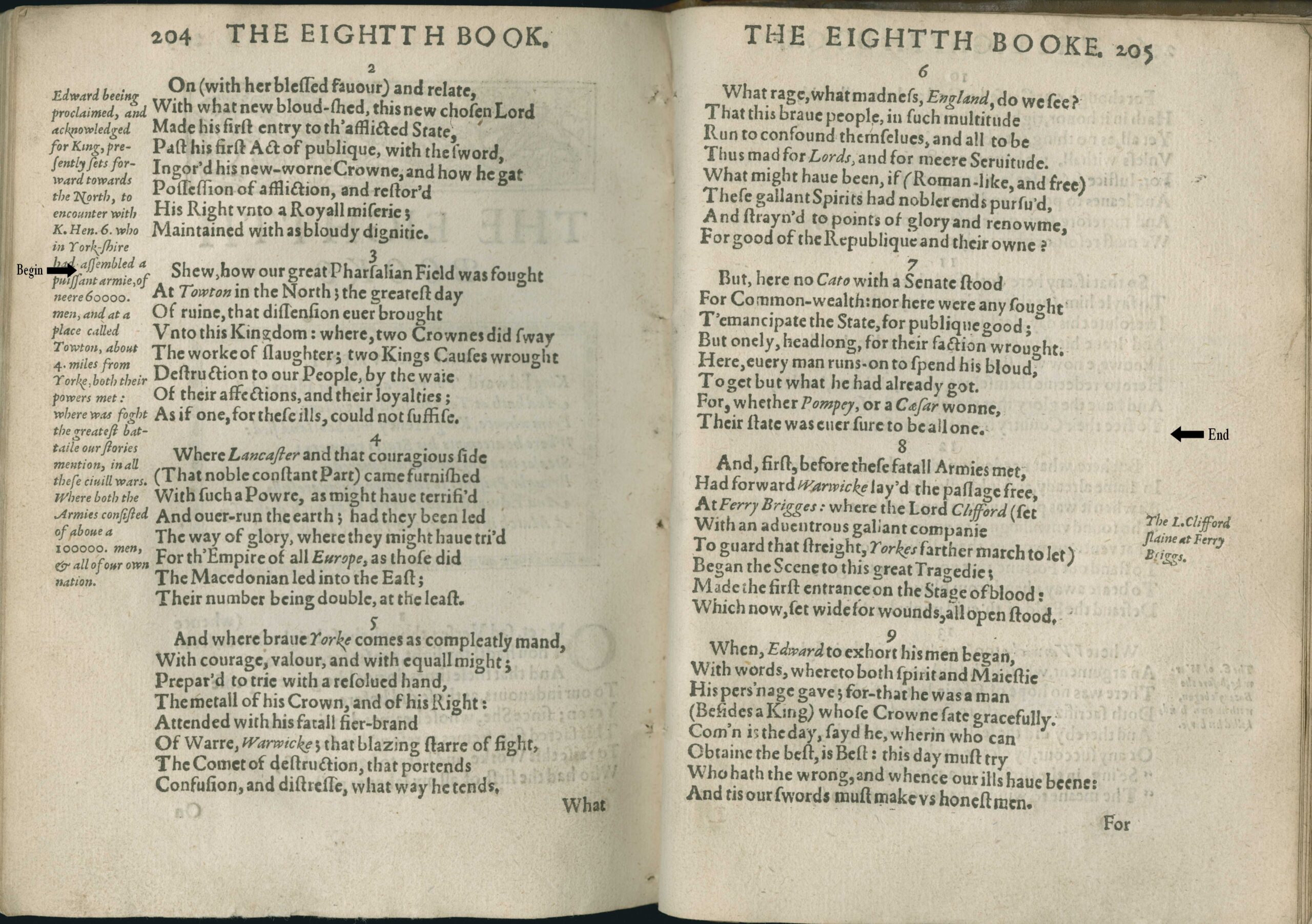
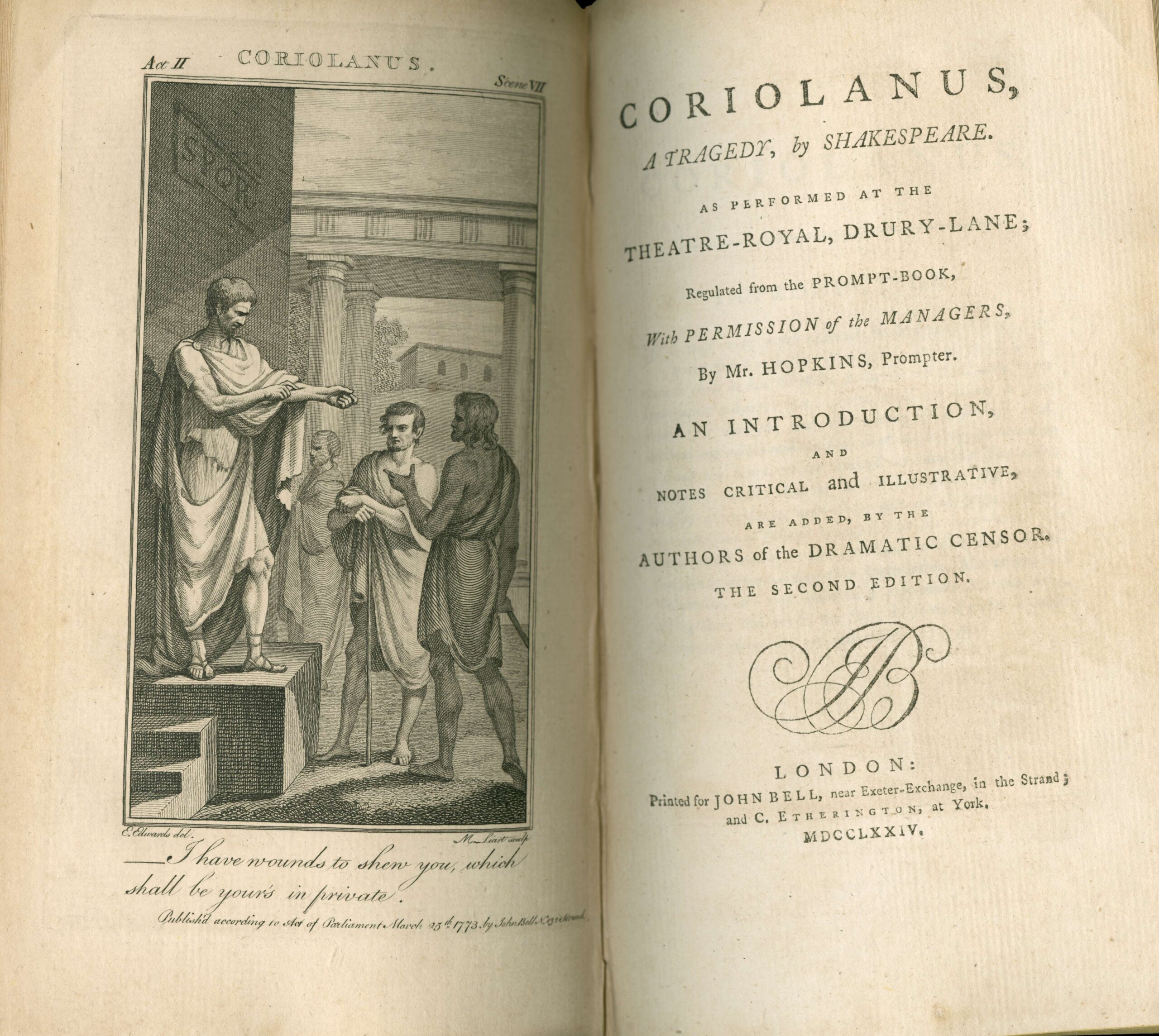
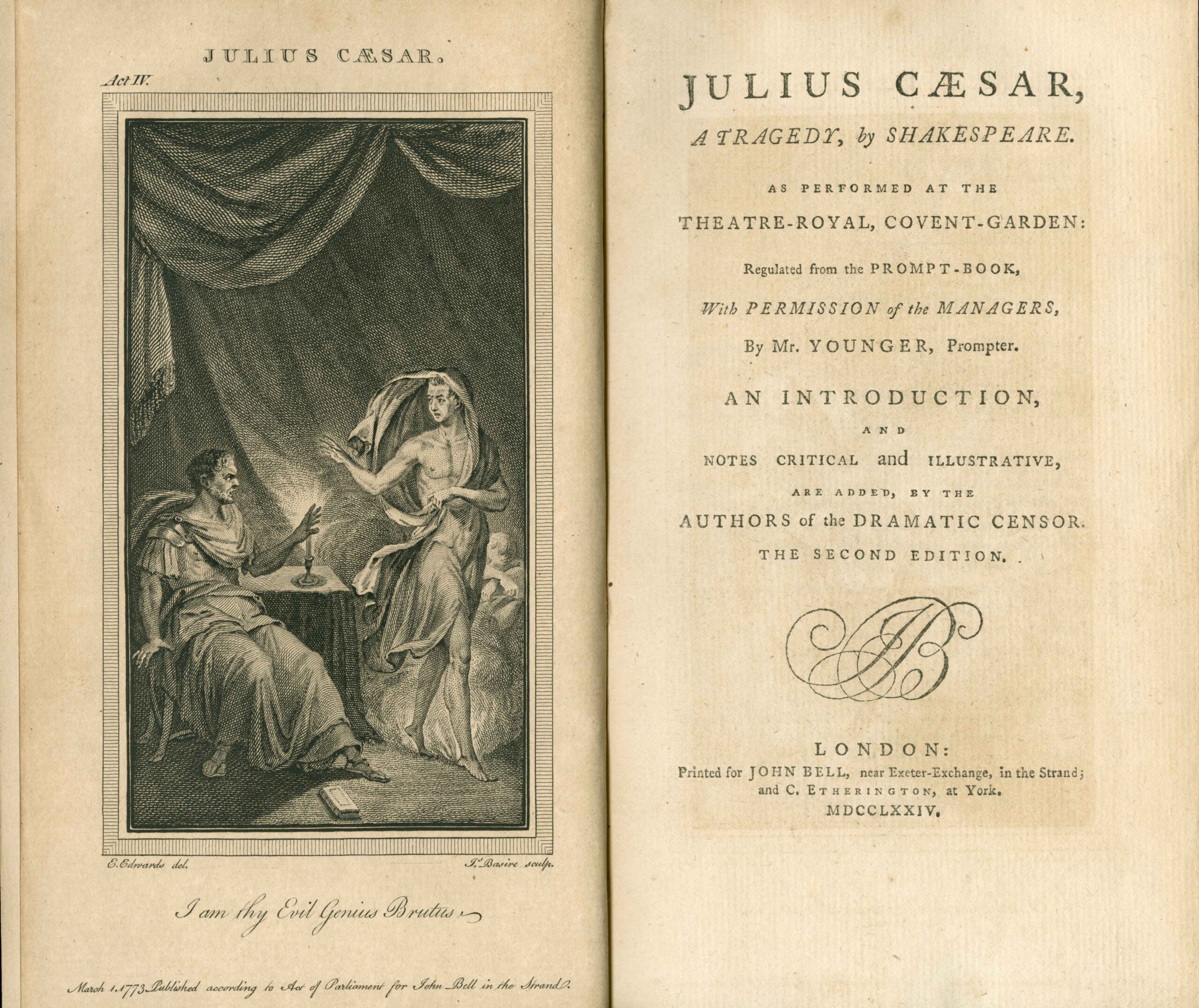
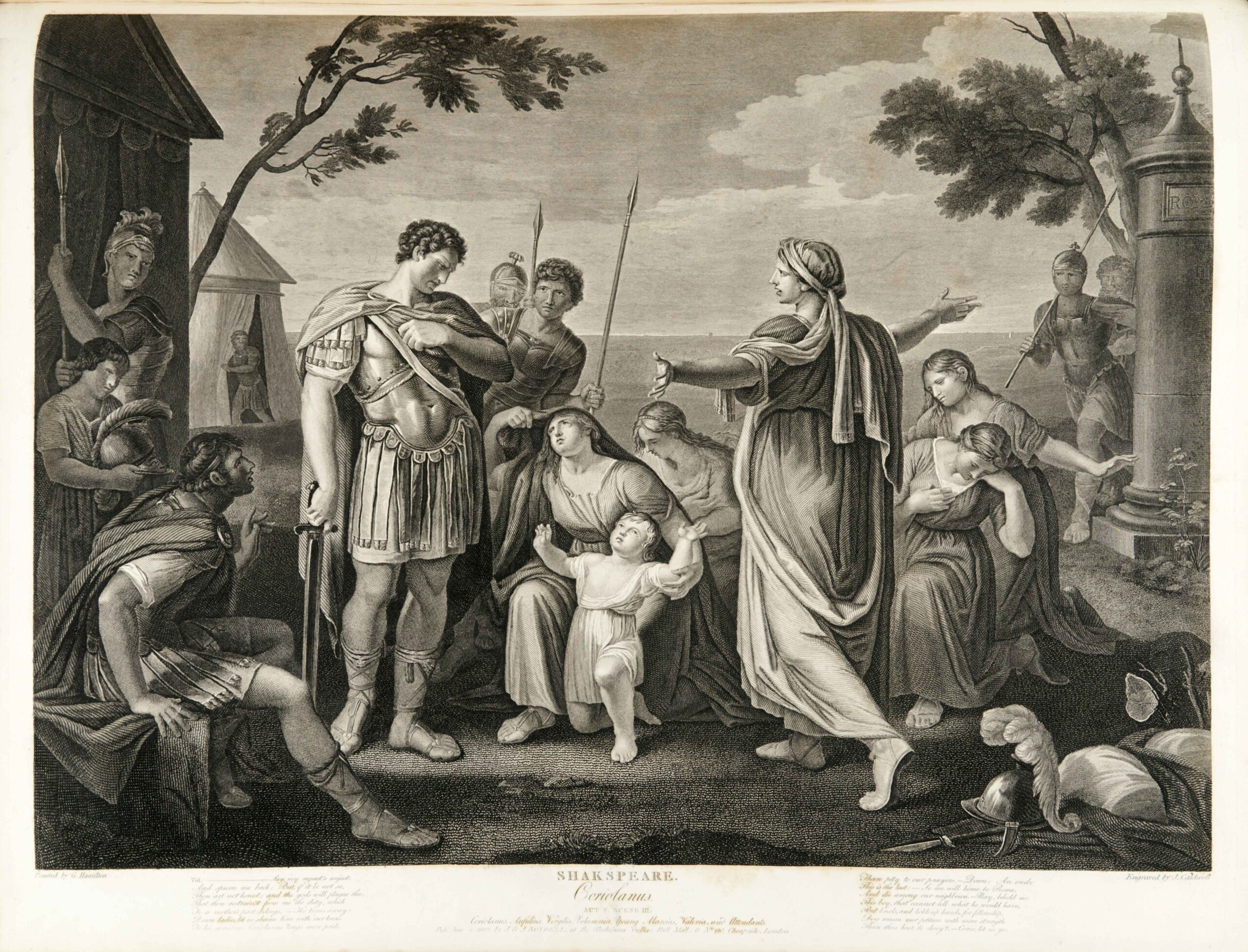
Further Reading
Arnold, Oliver O. “Chronology” and “Republicanism, Popular Politics, and the Rhetoric of Liberty in 1599.” In Julius Caesar, by William Shakespeare. Upper Saddle River, NJ: Pearson Education, 2010. xlv-liv, 160–181.
Bliss, Lee. “Introduction.” In Coriolanus, by William Shakespeare. Cambridge, UK: Cambridge University Press, 2000. 27–41.
Karrow, Robert W. Mapmakers of the Sixteenth Century and Their Maps: Bio-Bibliographies of the Cartographers of Abraham Ortelius, 1570: Based on Leo Bagrow’s a. Ortelii Catalogus Cartographorum. Chicago: Speculum Orbis Press, 1993.
Koks, Frans. “Ortelius Atlas.” Library of Congress. http://memory.loc.gov/ammem/gmdhtml/gnrlort.html.



